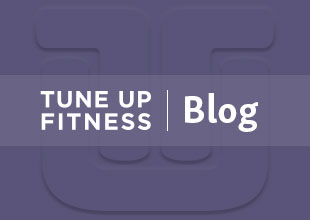
My manfriend accompanied me on my recent trip to New York City for the YTU Integrated Embodied Anatomy training.
We were both excited – you see, we hail from small town, Canada and we had big plans for our trip to the big city. However, on the plane ride, my partner, who was on the mend from a long bout with a cold, had a coughing fit and tore an intercostal (one of the small muscles between the ribs). This proved to be completely debilitating. Our plans came to a screeching halt. The injury prevented him from laughing, stretching, coughing, breathing deeply, and even lying down to sleep. He described the pain as “like being stabbed in the ribs”. Ouch!
The timing was perfect for exploring the question … Is there something that can be done to strengthen and fortify the intercostals against future injury? I was, after all, in New York to study the practical applications of Anatomy! Could I use my new knowledge for the benefit of another human being?
I put on my thinking cap and got to work. First learning about what the intercostals do.
There are two kinds of intercostals: internal and external. The internal intercostals assist with exhalation by drawing the ribs downward and decreasing the space of the thoracic cavity. The external intercostals draw the ribs upward, increasing the volume of the thoracic cavity.
The intercostals are easy to access but sensitive to touch – but you can find them by sliding a finger into the space between your ribs. Then take several slow, deep breaths and any expansion or collapse in the spaces between the ribs.
It is not uncommon for extended runs of sneezing and coughing (hello allergy season!) to result in torn or strained intercostals. But there are things you can do to make these muscles more supple and strong. Yoga Tune Up® to the rescue!
Try the following YTU exercises for strengthening and stretching these small, but important muscles. If you currently have an intercostal injury, wait until the injury is healed before beginning a strengthening and stretching program – and be sure to move gently and mindfully.
To stretch and strengthen the intercostals:
Tadasana with end of exhalation contraction
Tadasana with end of inhalation contraction
Jathara Parivartanasana with end of exhalation contraction
To stretch:
Parighasana
Read about exercises for core strength.
Read more about your diaphragm.
Learn about Yoga Tune Up at home.


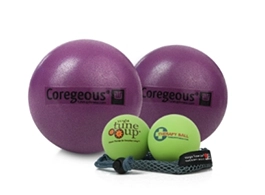
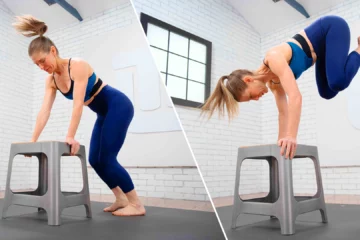
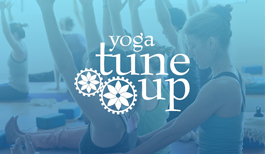



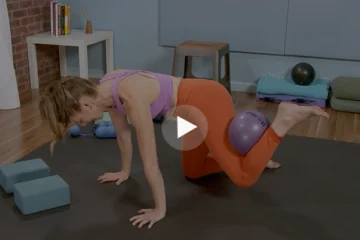
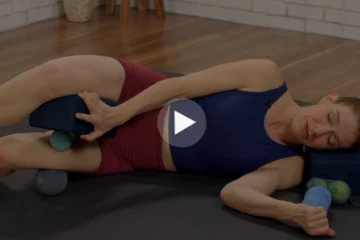
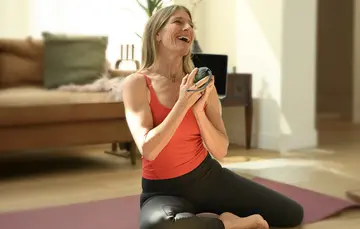

omygosh! It was completely unfathomable to me until now (!) that you could tear your muscles from something so common as a coughing fit!!!
Thank you so much for breathing (😉) some life into this oblique anatomy lesson! I was just reading up on them yesterday and their role in side plank… never considered that they’d also play a role in breathing as well.
I wonder if “by drawing the ribs downward” actually means allowing the ribcage to soften back towards the spine so the movement is more one that’s collapsing towards centre/spine vs moving towards the ground (if one is seated or standing, that is) -OR- are the ribs truly moving downwards & this is what results in compression of the lungs for the exhalation? & conversely for the external obliques action of “drawing the ribs up”… is this lifting the ribcage? I’m going to have to play around with this later to see for myself. These contractions at the end of the inhalation & exhalation almost sound like bandha work.
I recently tried a hybrid of Sidewinder & Jathara Parivartanasana in a TuneUp class & just loved it so can’t wait to try your other suggestions too! Thanks Amanda!
One of my students fractured a rib on a bike. Rehabilitation: Nothing. Expect.
Result: loss of mobility and possible atropy of theses muscles. These exercises would surely be genial to propose for the resumption of the activities. Isn’t it?
We haven’t covered these particular muscles yet in our YTU training, and I somehow still have room in my brain to take this information in! lol
Especially with such a clear story of how it has impacted someone close. I can absolutely relate to these sensations and feelings the last time I had a cold, and now I know how to strengthen them. Thanks Amanda!
I can see how these breathing techniques and poses could be beneficial in those last lingering days of a cold when the rib region feels achy and tight due to coughing. I’ll try this practice next time I’m getting over a cold or as preventative maintenance in between.
Thank you, this was super helpful!
Thanks Amanda, I now know more about our intercostal muslcles!
Thanks Amanda. I am interested in this topic as both a movement teacher and as a music teacher. I work with wind players in their 20s and they tend to have shockingly limited mobility and strength in the rib cage. I appreciate this refresher on the function of these muscles (I always get the internals and externals mixed up).
Thank you for the article Amanda, this time of year there is always someone coming into class complaining or knows of someone that has injured their intercostal muscles from coughing. I’m definitely going to add some more breathing exercises into my classes.
Great article! More and more, I am interested in the anatomy of breath, so always delighted to read a blog that includes a little refresher course on the intercostals and their role. In the list of yoga postures at the end, do I understand correctly that “end of exhale contraction” would be to brace the transversus abdominis? I’m not sure how to do perform an “end of inhale contraction.” Would you spread your ribs while holding the breath– kind of like uddiyana? Thanks!
I enjoyed reading this article and learnimg more about the intercostal muscles. I never gave them credit till my ribs became the biggest part of my body almost. What the heck happened? I started to watch and listen. No breath ever, retention and stress. No love for the intercostals and they revolted. Im learning to love them more and more each day and look forward to trying your suggested poses and glad you can look at ones “misfortune” , learn about it, turn it into gold and help others with it.
Nice article! Having a cough right now and going through Level 1, your tips helped. I also think that the Tubular core breathing would help and the boomerang against the wall to stretch the intercostal muscles. Will give your sequence a try!
I overstretched some of my intercostals when I had an intestinal bug (yes, vomiting) – it was incredibly painful and uncomfortable for over 6 months! I love stretching my sidewaist (love parighasana) but probably hadn’t been strengthening it enough. I’m incorporating a lot of sidewinder these days and savasana with side bend to try to balance the stretchiness in my sidewaist muscles with strength! I am allowing myself an occasional parighasana but always follow it up with strengthening poses, too. Thanks for your post!
Thanks Amanda. I’ve recently been working with the corgeous ball over the ribs and it works wonders for creating space in the intercostals and for breathing better.
Thanks for sharing Amanda! I never realized how sensitive the intercostal muscles were. I am nervous to cough and sneeze now. I have bad allergies!
Thank you for offering exercises to prevent future injury to the intercostals. So happy that I have done the YTU Level 1 ! I
I’m curious, how did you know that it was a torn or strained intercostal that your friend had? Was that obvious?
Very important yet largely neglected our little intercostals are! We can also access some stretch in them doing triangle in parallel, I love that pose too 🙂
So important, the intercostals! Thanks for sharing the exercises that emphasize how important the breath is for building strength as well.
I injured intercostals years ago from coughing and it was not fun. Thank you for teaching about strengthening and stretching these forgotten muscles.
Nice article. I have Systemic Lupus, and often struggle with inflammation of the intercostals–not fun, and a very different problem from that of weak muscles. YTU balls are great for working these muscles, but I think it’s great for yoga teachers to recognize that there’s folks out there like me, with inflammatory diseases who may have aggravation occur. A wise teacher recently told me, “See what tomorrow brings” and make adjustments from there as to how much pressure you’d apply with the therapy balls, or if it’s a day that you should simply skip it. Thanks for the blog!
Great article! I was recently introduced to the intercostals during a Rolfing session. In addition to strengthening the intercostals, the myofascia that weaves in and around the ribcage also needs to maintain its elasticity as well. Until I developed a more diaphragmatic breath (it’s a work in progress…), I would imagine I had a pretty good amount of adhesion between the ribs. Liberating that adhesion through Rolfing and then exercising those structures with deep and mindful breath probably does a world of good for my physiology!
An often forgotten muscle that we never really give a second thought about until we are incapacitated and can’t breathe properly, laugh or even enjoy life!! Thanks for the reminder that we need to be strengthening and stretching all muscles in the body to continue to reaffirm health and vitality and to keep our physical bodies moving from a space of integrity.
I’m curious… you only listed one pose for stretching – does Parighasana offer something to the intercostals that other side bends don’t?
Thank you Amanda for this article on the intercostals which often get overlooked! I have been working on breathing abdomino-thoracically in all directions the past year or so, and appreciate the suggested exercises to go along with this.
The intercostals are often forgotten and taken for granted even though they are working hard for us every day, every breath. They sure do find a way to get our attention when they are injured. Good advice for some TLC for these hard workers.
I imagine Boomerang would be a pose that would benefit intercostals.
Thanks for the knowledge! I’m loving your Level 1 this week!
I’ve known for years that I have a tight rib cage, but never really put much thought into how to stretch and strengthen the intercostal muscles. Thank you for the information and inspiration!
Thanks for the intercostal refresher! In addition to parighasana, another great YTU pose to stretch the intercostals is boomerang pose.
YAY YAY I love this suggestions I will try right away thank you!!
I have been a runner/jogger/shuffler for 30 years and I am very aware of intercostals when they cramp up and make the jog even more challenging. It it good to know that by adding few different variations to movements and breathing techniques I am already doing may help strengthen and lengthen these pesky little muscles.
So naturally as the lovely Amanda Tripp is my teacher, I was drawn to read her blogs 😛 As I was reading this I remebered having this convo at YBS and her telling this story to me. Thought it funny that this was the FIRST of my readings! thanks for the great info on how to strengthen those intercostals Amanda!
Interesting to learn that there are two types of intercostals! I had sore intercostals off and on for years after getting hit by a car and it was so tough to ease the tension. My PT used to press her fingers into them to release, but now I use a YTU ball to help. Thanks for the breathing exercises; I’ll try them out.
I never would have given these muscles much thought Amanda- thanks for pointing out the relevance of the intercostals! I’m sure injuring these muscles are more common than we think. It’s great to have another reason to focus on our breathing!
I remember injuring the intercostals while I was pregnant and walked my two 120 lbs Alaskan Malamutes. The next day my sides were sore and breathing and moving was painful. I have also been sick and was sore from all the coughing. We are using these muscles repetitively all day without thinking about until they become sore. I like the title, very cute 🙂
I teach prenatal yoga and find that my mamas have really sore intercostal muscles due to the uterus and baby growing. Especially in the last trimester of pregnancy, mama’s organs are squished up into the ribs cause more strain on the intercostals to hold everything in. My mamas struggle to take a complete breath and find that the diaphragm has limited space to truly expand. I love the exercises you listed and the use of Parighasana to stretch. Any lateral flexion of the spine give great release to my pregnant mamas 🙂
I’m no stranger to stretching my intercostals and practice variations akin to parighasana regularly. Lateral stretches feel glorious, especially in lateral extension of my right side. I know that there is tremendous value in strengthening and lengthening the intercostals but I feel like there’s something missing in my routine. I wonder if there is ball work that I can pair with these strength and stretching exercises that you may recommend? Something feels like it’s been stuck to my ribs for approximately 6 months now, preventing comfort in lateral extensions and rotations.
I wish there was an edit button!!! my right side hurts when I rotate my legs to the left. Dear lord I need to go meditate and become coherent again.
Thanks Amanda, I can honestly say that, aside from enjoying a stretch to these muscles, the intercostals have never crossed my mind as a muscle to be concerned about. Sadly I hadn’t appreciated all they do for me, or even thought about strengthening them. Pretty sure the fake cough in tubular core has changed my life!
Ugh… I meant the pain is in the right side when I let my legs rotate over to the right!
Thanks for the great blog. If I understood correctly in out Yoga tune up training today, our intercostals are linked with our QL as well as our psoas. If that is correct then I have had the aha moment that the reason my intercostals in the lower ribs hurt so much is because my QL and psoas are tight ( which one is the chicken or the egg??? not sure) all I know is that the Jathara Parivartanasana is super painful or full of unpleasant sensations through the left QL and lower rib intercostals when twisting to the left. Rolling the QL and intercostals on a regular basis has not reduced the pain factor. I guess I need to attack that psoas muscle!
Thanks for sharing! I did not know there are two kinds of intercostals 🙂
I really enjoyed this blog post. I loved the point you made about the internal intercostal assisting with exhalation. It’s so important to have that flexibility in the intercostals to assist us with breathing.
I like that you added the contraction at the end of the inhale. I also had no idea that there were two types of intercostals. Nor the fact that they are so sensitive and a sneeze could take them out. Thank you for shedding light on this muscle. Your breath work is great as it could be practiced at a desk at work. Also it is wonderful to imagine the intercostals as you breath!!
This article really sticks to my ribs. I read this article last year and almost every time i teach or practice a breathing exercise I think of these muscles expanding and contracting.
Great article about the important and little know intercostals. I always find it funny that the muscles that are so important for everyday functions get such little airtime. Working to keep good flexible space between the ribs is vital to good posture, energy and overall health.
@Steeve:
Hi! Sorry about your injury – but so glad that you managed to resolve it right away. That’s wonderful! The YTU balls are totally safe to use on your rib cage. In fact, if you want to really get at those intercostals, you would need something even smaller than the OGs (like a finger) to really carve into the space between the ribs. Continue to take good care of you!
I went to Rib Fest Ottawa last Sunday, then pulled one of my left intercostals on Tuesday morning. I don’t particularly appreciate that type of irony, however it was an opportunity for me to indulge in the subject of intercostals.
As for my pulled “rib” it was really uncomfortable, so I totally relate with the debilitating aspects of what a tear could feel. 10 minutes with the YTU balls and an hour later, the discomfort was gone, and has not returned… yet.
That said, I have a question. How safe is it to rollout the intercostal region with YTU balls?
Interesting. So often we forget the smaller muscle groups and yet the play such an important role to ease the work of the larger prime movers. Cool!
Thanks for the great post, Amanda! I was frequently finding my breathing tight after practicing singing for a long time and of course when I was nervous about a new teacher/coach. I have been looking for ways to relax/strengthen those muscles particularly because I think it is so easy to equate muscle strength with muscle tightness for the uninformed, and a lot of my not-so-anatomy-savvy voice teachers had been telling me that “I’m strong, so I am very tight”. While it is certainly possible to strong muscles to be tight if not properly stretched, I know that I have many muscles that are strong but not tight, or supple, as you aptly put it. I will definitely be putting these techniques in hopes of cultivating strong and controlled, but tension-free breathing for my singing practice 😀
Thanks Amanda. This is a great story and good reminder of those small but important muscles. They are so sensitive so I couldn’t have imagined a way to strengthen them….I missed the obvious: breath! Sometimes, I forget that breathing involves muscles. I love to tune into the intercostals and just feel the relationship between the lungs, the ribs and those sweet intercostal mucles; interconnected, breathing tissue, keeping me alive!
Peace to you.
@JL.
I think you’ll find that the YTU Therapy Balls are the best place to begin with removing knots and trigger points. I would roll out the upper back, shoulders and neck to begin addressing those old knotty, gnarly spots first.
Let’s talk when I see you this weekend!
Hi Amanda, I just wanted to tell you that I did yoga tune-up today with an NHL player (after reading this blog last night and commenting on it) and he tells me at the end that he has a knot between his ribs on his back. I am guessing this would be intercostals? He has had this knot for 2 years now and actually said the whole time he was lying on his mat with me all he could feel under is back was the knot? I did Jithara Parivartonasana Variation 3 with him as I did a hip opening sequence with him so I am good there but not sure I really understand what else I can do over the summer with him to help with this knot? Thanks so much. JL
Hi, Amanda 🙂
This post was very interesting!! When I am practicing deep breathing, I tend more focused on diaphragm, because once you have no more space in your abdominal to expand, your chest expands automatically so I really didn’t pay much attention to the intercostals!!
When I run, I’m feeling fine for first 30mins, then gradually my right intercostal T6/7 gets sore. I thought I was getting fatigue on my tubular core so that my diaphragm was not symmetrically working. I will try the strength/ stretch exercises and see if still my right rib gets sore!! Thank you for sharing!!
I think this article just solved one of the mysteries of why I have always hated running. So often I would end up with that rib stabbing pain and a terrible time taking deep breaths. Now I know that it is likely from dysfunctional intercostals! This is brilliant, I love how learning about the nuts and bolts of our bodies helps us to make informed and conscious choices about of we move, function, feel and heal ourselves. And it helps us train towards the “meaningful task” in our lives. And one of those meaningful tasks for me is being able to run (no, not talking marathons just your average frolick or jaunt) without searing pain in my lungs, psoas, knees and ankles. Everyday I’m learning, thanks for lighting the way!
The intercostals may be small, but as you described (and your friend discovered first-hand), they do play such an important role in our livelihood and well-being! Like any other muscle, they need to be strengthened and lengthened to maintain their ability to contract and expand and to respond to the rigors of daily living and breathing; and of course, withstand the occasional coughing/sneezing marathon episode. Thank you for the great blog along with the list of YTU exercises to help us get these muscles supple, strong and responsive!
I enjoy how this blog explained how there are 2 types of intercostals INTERNAL and EXTERNAL… the internal intercostals help with exhaling air from the lungs bringing ribs towards the back body and preventing them from sticking out as well as decreasing the thoracic cavity space. Then the external intercostals help on the inhalation, drawing the ribs outward and creating more space in the thoracic cavity for oxygen. I will attempt to add this anatomy understanding into my pranayama excercizes and possibly also into teaching Tubular Core. Thanks for the details!
I had pneumonia two years ago and my breathing has been compromised since.
I notice a remarkable difference when I practice with the YTU balls, in particular through the thoracic ribs.
I will try the tadasana strengtheners and follow up with Parighasana and YTU ball massage through the thoracic spine.
Oh, the intercostals! I’ve helped a client recover from the same injury your manfriend did and I wish I had known then (pre YTU training) what I know now. These strength and stretch exercises are so valuable!
This is son interesting! thanks for sharing. I wasn’t aware of the actions of this muscles and that coughing can cause that injury.
This exercices are very good to get awarenes and strengthen them and avoid get injured.
[…] to your Intercostals The intercostals are an integral part of your integrated […]
I would add, Amanda, Tubular Core.
It’s interesting that I fell on this article; I have been practicing the different variations of Jathara Parivartanasana with quite a few of my clients, actually, and I had never made that connection with the intercostals.
Wow Amanda!! Brilliant article! I’ve always “zombied out” on you when you spoke in class. It’s so interesting to here you talk. I just love your style! (: Keep up the nice work!
Great advice for stengtheing the intercostal. As for stretching ;I found that after a session with the Tune Up balls into the Thoracic Erectors WOW!! My rib expansion was huge, you could really feel your breath all the way around. Love those balls.
Good to know that you can strengthen and bring awareness to the intercostals just by breathing. More context for my classes. Thanks!
This is such a wonderful reminder of some of these muscles we often ignore and forget about yet are so important to basic functions in life such as breathing. The tubular core exercise seems like it could be a wonderful exercise to help strengthen the intercostals as well. In addition the tubular core exercise is great for us to connect with effective breathing and to help stabilize the spine. As a school nurse I have kids who suffer from Upper respiratory issues as , asthma well as allergies and have intercostal muscle pain and this seems like a wonderful idea to teach middle school to high school students as well in the nurse’s office. Thanks so much great tip!
The fact that the internal intercostals assist with exhalation drawing down the ribs and decreasing the thoracic cavity space and the externals assist inhalation by bringing the ribs upward, and increasing thoracic cavity volume was very informative, I can see how these actions might work in tandem with the expansion and contraction of the diaphragm to effect breathing. The fact that yoga tune up exercises can strengthen these muscles to prevent injury by both stretching and strengthening them is just one more fascinating piece of information to add to the store of knowledge I am gleaning from YTU teacher training.
Donna, in response to your question: I don’t know … Give it a try and report back!
I somehow ended up with an intercostal cramp once and found it to be horribly debilitating. A full exhale, i.e. contracting those internal intercostals, had me doubled over. I tried sticking my fingers between my ribs, I tried backbending over a phsyioball and it didn’t work. The only thing that got that nasty cramp to slowly release was a conscious, active inhale followed by a passive exhale. The first few breaths I had to stop the exhale short, but eventually the cramp abated and I was able to breath normally. This exercise for strengthening those babies is going to become part of my regular practice! Question: Would you recommend doing this in the pool collarbone deep to further enhance the strength on inhalation?
This is so good to know how to strengthen these small muscles that most aren’t even aware of. I know for myself, I have tension alone in my innercostals and light massage helps to bring blood flow back to the area. Its interesting to think that our breath could be limited or enhanced by these muscles and that they need attention and care like the rest of our body. Got to love the nooks and crannies!
Amanda, try this out:
Take a full exhalation. At the end of the exhalation pack in every core muscle you can find. Compact your rib cage! corset your mid-section!
Then do the same thing while retaining an inhalation.
If you need further clarification, just let mek know!
Hi Robyn.
Yes, for the end of the exhale/inhale contraction, you simply exhale or inhale and then tubularize your core!
I never thought about the over stretching the intercostal muscles, maybe because they are such small muscles. SInce they are such tiny muscles it makes sense that they can be torn easily. Thank you for your strengthening excercises, I will definitely try to incorporate them into one of my future classes–muscles of respiratrion are so important!
Next time you get a massage ask for some intercostal work… heaven!
again I am leaving a comment as yesterday’s comment from my phone did not register.;-(… Anyway, I rarely reference the intercostals as they seem to just carry on just fine on their own assisting in automatic respiratory. However I had not realized that they could actually be torn due to a sneeze or cough. I wonder how likely that is to occur. In any case, I seems the side bending lateral flexions would help strength those little guys and bring more awareness to that area.
The intercostal muscles somehow are rarely emphasized in a regular yoga class but as you mentioned so important to the breathing process. I like the simple exercise of rolling the rib cage 380 degrees. Seems to always stretch my rib cage and enable me to take a deeper breath.
I like the instruction “knit the ribs down”, which gives me that visual aide of the intercostals acting as laces to anchor those ribs in place which would be helpful during both inhalation and exhalation contraction.
This was very informative! I have an ex-boyfriend who thought that he had “torn a rib” after prolonged and very intense coughing episodes that he suffered as a cause of being a heavy smoker. This provided me with some great information on what he likely tore, his intercostals. I like the pose recommendations! Really helpful.
Training these muscles also helps you sing better! They are key in supporting the vocal apparatus, so singers and public speakers can benefit for these exercises.
During a bodywork training I had one of the teachers compared the rib movement when breathing to venetian blinds – and the intercostals are making this movement happen. So important to keep them both strong an pliable – especially as we age.
I never thought about training the intercostals either but it makes sense! Can you please explain further on how to contract them? Is it akin to engaging the tubular core?
I second Taylor’s thought – I didn’t really know there was a way to voluntary strengthen the intercostal muscles. In regards to the YTU exercises you suggest – how exactly do you contract the intercostals? I’m having a little difficulty understanding how exactly to do that, and would love to try them out!
It’s so interesting that you should mention that – because that’s exactly what my partner said. It had never occurred to him that he might even want to train his intercostals until this happened. At which time, it became PAINFULLY clear to him how vital the intercostals are to a number of basic functions! Keep tuning up!
Not sure why, but it never even crossed my mind to ‘train’ the intercostals! Genius. Thanks for the sequence and suggestions. My grandfather broke a few ribs while staying with me once, and if intercostal pain is anything like that rib pain seemed – I want nothing to do with it!